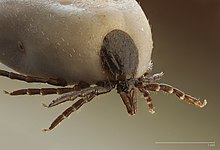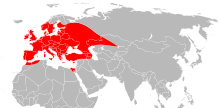Ixodes ricinus
| Ixodes ricinus | |
|---|---|

| |
| Ixodes ricinus complete view (starved) | |

| |
| Close-up view (engorged) | |
| Scientific classification | |
| Domain: | Eukaryota |
| Kingdom: | Animalia |
| Phylum: | Arthropoda |
| Subphylum: | Chelicerata |
| Class: | Arachnida |
| Order: | Ixodida |
| Family: | Ixodidae |
| Genus: | Ixodes |
| Species: | I. ricinus
|
| Binomial name | |
| Ixodes ricinus | |

| |
| Range of I. ricinus (marked in red) in western Eurasia and North Africa | |
Ixodes ricinus, the castor bean tick, is a chiefly European species of hard-bodied tick. It may reach a length of 11 mm (0.43 in) when engorged with a blood meal, and can transmit both bacterial and viral pathogens such as the causative agents of Lyme disease and tick-borne encephalitis.
Description
In common with other species of It has a hard dorsal shield which covers the entire opisthosoma (abdomen), but only part of it in females and nymphs.[2] I. ricinus is the largest of the three common species of Ixodes in the British Isles (the other two being I. canisuga, the British dog tick, and I. trianguliceps, the vole tick). Adult males are 2.4–2.8 mm (0.09–0.11 in) long, and unfed nymphs are 1.3–1.5 mm (0.05–0.06 in) long; females are 3.0–3.6 mm (0.12–0.14 in) long before feeding and 11 mm (0.43 in) long when engorged.[3]
Distribution
Ixodes ricinus is found across Europe and into neighbouring parts of North Africa and the Middle East, extending as far north as Iceland and as far east as parts of Russia.[3] Its northern limit seems to be determined by environmental factors, including temperature, since a series of mild winters in Scandinavia coincided with an expansion northwards in the range of I. ricinus.[4]
I. ricinus is most frequent in habitats where its hosts are plentiful, including
Role of climate change
As greenhouse gas emissions alter climatic conditions everywhere on Earth at a rapid rate, the range of conditions suitable for various species changes, and Ixodes ricinus is no exception. Some research expects it to become 5–7% more prevalent on livestock farms in Great Britain, depending on the severity of climate change scenario followed.[6]
Lifecycle
Ixodes ricinus has a three-host
Disease transmission
A number of
Natural enemies
The
Taxonomic history
The
See also
References
- PDF). Antenna: Royal Entomological Society. 42 (2): 61–65.
- ISBN 978-0-7234-2960-9.
- ^ a b c d e f g h Frank L. Ruedisueli & Brigitte Manship. "Background information: Ixodes ricinus". University of Lincoln. Archived from the original on April 2, 2015. Retrieved July 22, 2010.
- PMID 10656851.
- ^ a b "Ixodes ricinus: European Castor Bean Tick, Castor Bean Tick, Sheep Tick" (PDF). Iowa State University. September 2009.
- S2CID 252247062.
- ^ Mikula, P., Hromada, M., Koleničová, A., Pjenčák, P., Fulín, M., Olekšák, M., 2011. Prevalence of Ticks of birds in Slovak Karst. Folia oecologica presoviensis 5(4): 56-64.
- ISBN 978-1-4020-6242-1.
- PMID 29642819.
- PMID 32571129.
- ^ Glen M. Kohls (1957). "Acarina: Ixodoidea" (PDF). Insects of Micronesia. 3 (3): 85–104.
- .
External links
 Media related to Ixodes ricinus at Wikimedia Commons
Media related to Ixodes ricinus at Wikimedia Commons
